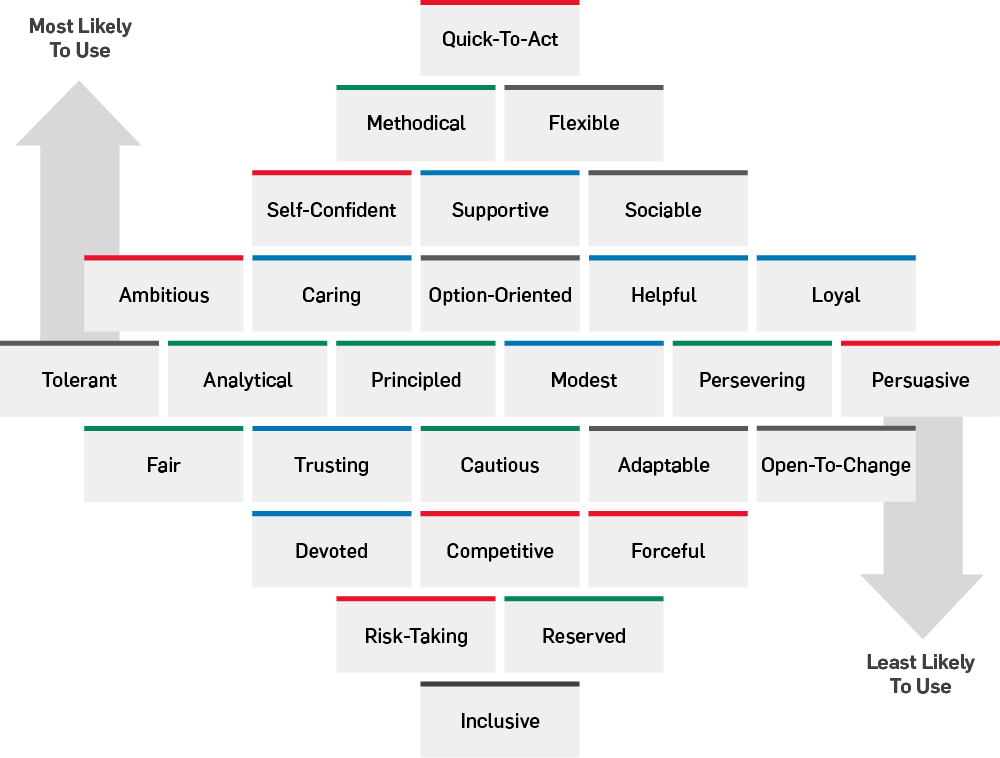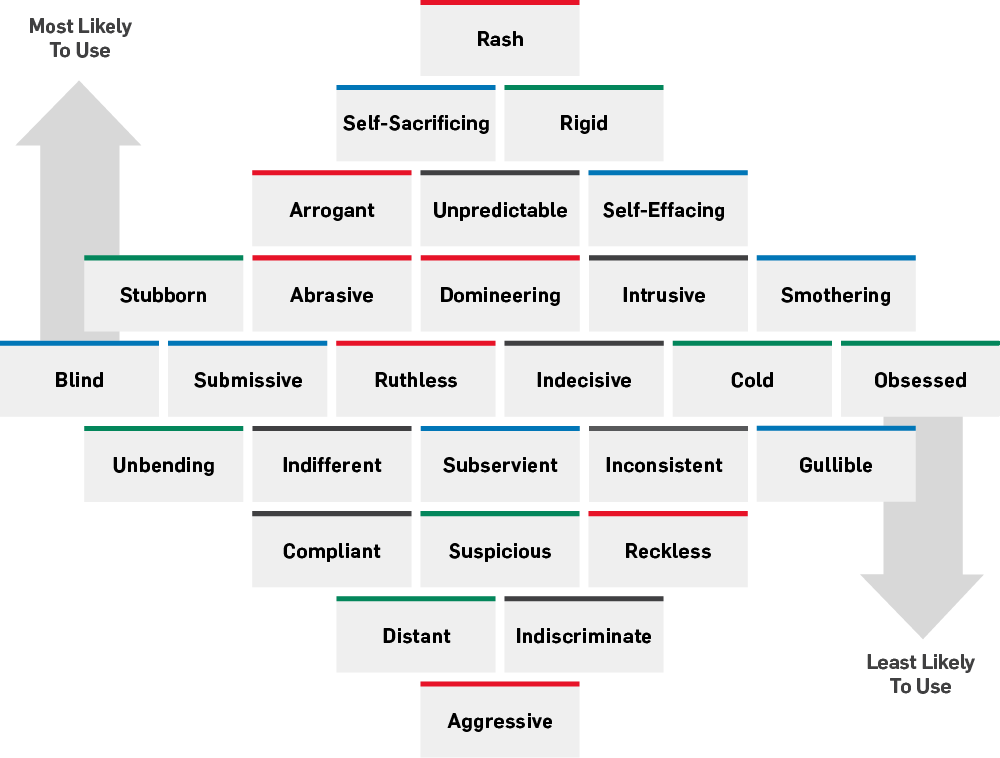Dear Crucial Skills,
There is an assistant director in my department who is awful to work with. She makes her team nervous to fail, so they are dishonest with her about the status of projects. I’ve voiced this concern to my director, whom we both report to, but nothing has changed. I want to have an honest conversation with this assistant director, but I’m not sure how to approach it. Any suggestions?
Signed,
Collision Repair
Dear Collision Repair,
Unfortunately, your challenge is a tale as old as time. At Crucial Learning, we sometimes joke that the hardest thing about working with people is… the people. But what if you could gain a more generous view of your colleagues—even those you struggle to work with? What if you could learn to see your colleagues not by their most frustrating qualities, but by their strengths?
Not long ago, we acquired a powerful personality assessment that can help with that change in perspective. It’s called the Strength Deployment Inventory, and it gives people a view of their motives, their strengths, and how their motives shift when experiencing conflict. The assessment has been shown to improve self-awareness, helping people better use their strengths and throttle behaviors that might irritate others. When taken as a team, it also helps people better understand their colleagues.
The SDI offers a view of personality based on motives, called a Motivational Value System (MVS). The MVS highlights the core drivers of behavior, and each person shares a blend of three primary motives: People, Process, and Performance.

This means that some of us predominantly achieve a sense of self-worth when we help others (People). Some of us do so when we perform at high levels and achieve goals (Performance). Some of us do so when we work independently, think logically, and establish order (Process). And if you’re thinking, “I like to do all three of those things,” it’s because we all have some blend of all the motives.
While you can’t always tell what a person’s MVS is based on watching their behavior, it’s possible that your colleague is highly motivated to perform well and thus comes down hard when people fail. Now, stop and consider, do we need people in our organizations who are motivated by performance? Yes! Of course we do. If there were only people who were motivated by process, we might iterate and fine-tune endlessly while deadlines slip. If there were only people who put the needs of team members above everything else, we might build a culture that is accommodating and yet struggles to accomplish goals. One thing the SDI helps us understand is the value of personality differences, and that understanding can improve our interactions and strengthen teams.
So, while your teammate is showing up in a way that you find challenging, take a moment to consider what her motives might be. Her desire to push the team to succeed may ultimately ensure success for everyone.
Something else you should consider: your personality affects your view of her behaviors. For example, a person who is process-oriented is more likely to see performance-driven behaviors as reckless. Or a person who is people-oriented may see performance-driven behavior as arrogant. And a performance-driven individual might see people-oriented behaviors as mushy and weak. See what I’m saying? So, while your director could benefit from modifying her approach, it may be that you could benefit from modifying your perspective. This is what I mean when I say the SDI improves self-awareness.
But back to your colleague. How can we help her gain awareness of her behavior?
When people take the SDI, they learn what their top strengths are from a list of 28, like Loyal, Ambitious, or Adaptable. Your colleague’s top strengths might be Competitive, Forceful, and Ambitious. While those strengths can sound intimidating, consider, do we need competitive, forceful, and ambitious people in our organization? Yes! Of course we do. We need people who have big aspirations and who are tenacious in achieving them.

And yet, every strength can be overdone. For example, when someone overdoes Competitive, they are more likely to be viewed as Aggressive. Forceful can be experienced as Domineering, and Ambitious as Ruthless. And on it goes. Every strength can be experienced as an irritating weakness by others when overused or misapplied.
While you might describe your colleague as aggressive, domineering, and ruthless, the point is to understand that those qualities are the flip side of a strength. When you understand that about others’ behavior, you can view them in a more generous way, and more importantly, you can approach them more productively.

The easiest way for you and your colleague to better understand motives and strengths is to take the SDI assessment. But if that’s not an option, you can use this insight to improve your Crucial Conversation.
The SDI insights can help you master your story (i.e. understand why people show up in certain ways), find mutual purpose (i.e. identify goals you share), and create a path to action (i.e. how to approach others in a way that will speak to their motives). So, as you approach your colleague, here are a few ideas:
- Master Your Story: Consider that while you think your colleague is showing up in “awful” ways, she isn’t actually awful. Rather, she may care so much about achieving goals that she is losing sight of how her behavior is being experienced by others. But ultimately, she wants to succeed, and this is a good thing. Also, remember that your perspective is influenced by your motives. If you wouldn’t behave as she is because your motives relate more to people or process, you’re more likely to feel irritated by performance-oriented behaviors.
- Find Mutual Purpose: When you approach her, communicate that you also care about the team’s success—in fact, everyone does. At the same time, there are things she is doing that are getting in the way of that success. If you can find a way to work better together, you’ll be even more likely to achieve your goals.
- Start with Facts: When giving feedback, keep it factual rather than share broad accusations. Don’t say, “You’re awful to work with.” She can’t act on that vague feedback. Rather, describe behaviors such as, “You called George an idiot when he made a mistake.” Or “Carlos said he could hear you on the other side of the building when you expressed your frustration with others last week.”
- Share Natural Consequences: Next, share the natural consequences of her behavior—and be sure to highlight how it may be undermining her primary motive. She may not care to know that her behavior causes people to feel emotional and upset, but she might care that her behavior is hindering results. Explain that, when she gets upset, people are dishonest with her about the status of the project, causing the team to miss deadlines, go over budget, and come short of results.
Your colleague likely has good motives and strengths, but it sounds like she is showing up in a way that compromises what she cares about most. If you can help her see how she is overdoing her strengths, maybe she can learn to modify them slightly or use other, more productive behaviors to create a more successful environment.
And if you’d like to experience the SDI, take our free version of the assessment. It’s a great way to begin accessing these valuable personal insights.











I find my SDI output varies depending on where I am; circumstances and environment seem ti influence the way I act.
I.e., at home, don’t act like you’re at work…
I agree with Thomas Benzoni above. It generally seems that one should take the SDI with a certain environment in mind – like their work team or a volunteer organization in which they are a member. I also find that the strengths and weaknesses of others in an environment in which I operate influence the way I employ my own strengths. If, for example, there is a team with a lot of strong social strengths, I will push more for performance or process. But if the team already has strong performance members, I will shift to using my social strengths more. I’m pretty sure a lot of people function like this.